L KER




| Page 4A
| Page 3B
& Jetsam | Page 9B
| Page 11C
| Page 5C





| Page 4A
| Page 3B
& Jetsam | Page 9B
| Page 11C
| Page 5C
Summer is finally here, and what better way to enjoy it than on one of Wisconsin’s lakes? Throughout the summer there are many great activities to do with family and friends that if you blink, you may miss out.
This is this year’s first edition of the Laker as we cover Wapogasset, Bear Trap, and Round lakes. Learn what the lake association has going on during this summer for lake residents on Wapogasset and Bear Trap lakes, and the unfortunate spreading of invasive species taking hold on Round Lake. Follow the ingenuity of a small business owner who is changing the way that docks are put in and taken out.
The Laker will also feature some great tips while out on the water this year, going over safety and how to catch the biggest Yellow Perch.
However you spend your time, have fun doing it!
The publication dates are as follows:
Laker #1 – Friday, May 17
Laker #2 – Friday, June 7
Laker #3 – Friday, June 21
Laker #4 – Friday, July 5
Laker #6 – Friday, August 9
Laker #7 – Friday, August 23
Enjoy this years Laker!
Justin Runberg, Editor editor@theameryfreepress.com
 By Justin Runberg editor@theameryfreepress.com
By Justin Runberg editor@theameryfreepress.com
Lake Wapogasset and Bear Trap are unique to the area because of how much history is known about the lakes. Starting well over a hundred years ago, the lake folk put together a lake association to help become stewards of the water and what the area had to offer. Since its inception it has only gotten better, managing the water’s health and creating fun things to do for young and old families alike. Their goal is to educate people of the rules on the lake and to also create meaningful memories on the lake.
“The path that the association has chosen to go is to try and educate our lake residents on what's best for our two lakes, their health and so on. And because of that, we've put together these programs to get the information in the people and the communications will continue to reinforce that so that hopefully we can get voluntary support of our lake residents,” said Jim Andersen, Lake Improvement Association Communication Education Chairperson.
To start the season off, the lake association for Lake Wapogasset and Bear Trap wanted to make sure the residents were up to par with their knowledge of

safely navigating the lakes’ waters. Handouts will be delivered to those who live on the lakes for boating safety and laws, responsibilities, and a small booklet for those with shoreline property.
One thing that is different this year on the lake is the suggested wake surfing area. Wake boats are used for this and use a process that enables the craft to take in water so it sits lower in the water. When it sits low in the water, it creates a much bigger wake preferred by wake surfers. However, the size of the wakes could




As the weather warms, and the lakes fill up, there is one species that is sought after, year after year. The Yellow Perch is one of the most popular angler fish species in Wisconsin. According to the Wisconsin Department of Natural Resources (WIDNR), Yellow Perch is a glacial lake species, meaning that they can be found where there were once glaciers in the state. In the southwest, it is harder to see the species
Derek Jorgenson Cell 715-553-2466
2185 210 St., Luck, WI 54853
because of that reason.
However, besides the southwest part of the state, they are thriving elsewhere throughout Wisconsin. They can be located in the state’s Boundary Waters, both Lake Superior and Michigan, and also the Mississippi River. Worldwide, the Yellow Perch can be found mostly in the northern hemisphere.
Every year the typical time to see the fish spawn is the middle of spring. It occurs shortly after the ice is out of the lake, according to WIDNR, in either middle
of April or May. The water will have to be the ideal temperature as well. Usually, the Yellow Perch will spawn in water temperatures of 45 to 52 degrees. Their spawn coincides closely with the Walleye and sucker spawns as well. Yellow Perch are also unique in how they manage their young. For some species of fish, they will make a nest and watch over their eggs, protecting them from harm. Yellow Perch do not adhere to either. They are what the WIDNR considers a “random spawner,” meaning that they do not make

nests nor guard their eggs. After incubation of the eggs, it takes them about 12 days for them to hatch, in ideal circumstances.
If you find yourself on the lake with a fishing pole in hand, you might be curious on how to catch these panfish. Yellow Perch are primarily bottom feeders, according to WIDNR. When they go to take the bait they make slow, but deliberate bites to let you know you have one on the hook. Since they are bottom feeders, they will eat most anything that goes their way. However, they do have some favorites. Some bait that would work better than others for catching a Yellow Perch are minnows, worms, and insect larvae. If no live bait is available, the tackle to use would be something short and whippy for jigging.
Since the Yellow Perch spends its time at the bottom of the lake, they prefer cooler water temperatures, anglers will have to search in deeper water to find them. Typically, the species travels in schools of fish. The schools numbers varies from small to very large with some even being numbered in the hundreds.
Yellow Perch are also not a very large fish. On average, the Yellow Perch only measures to about seven and a half inches long. The
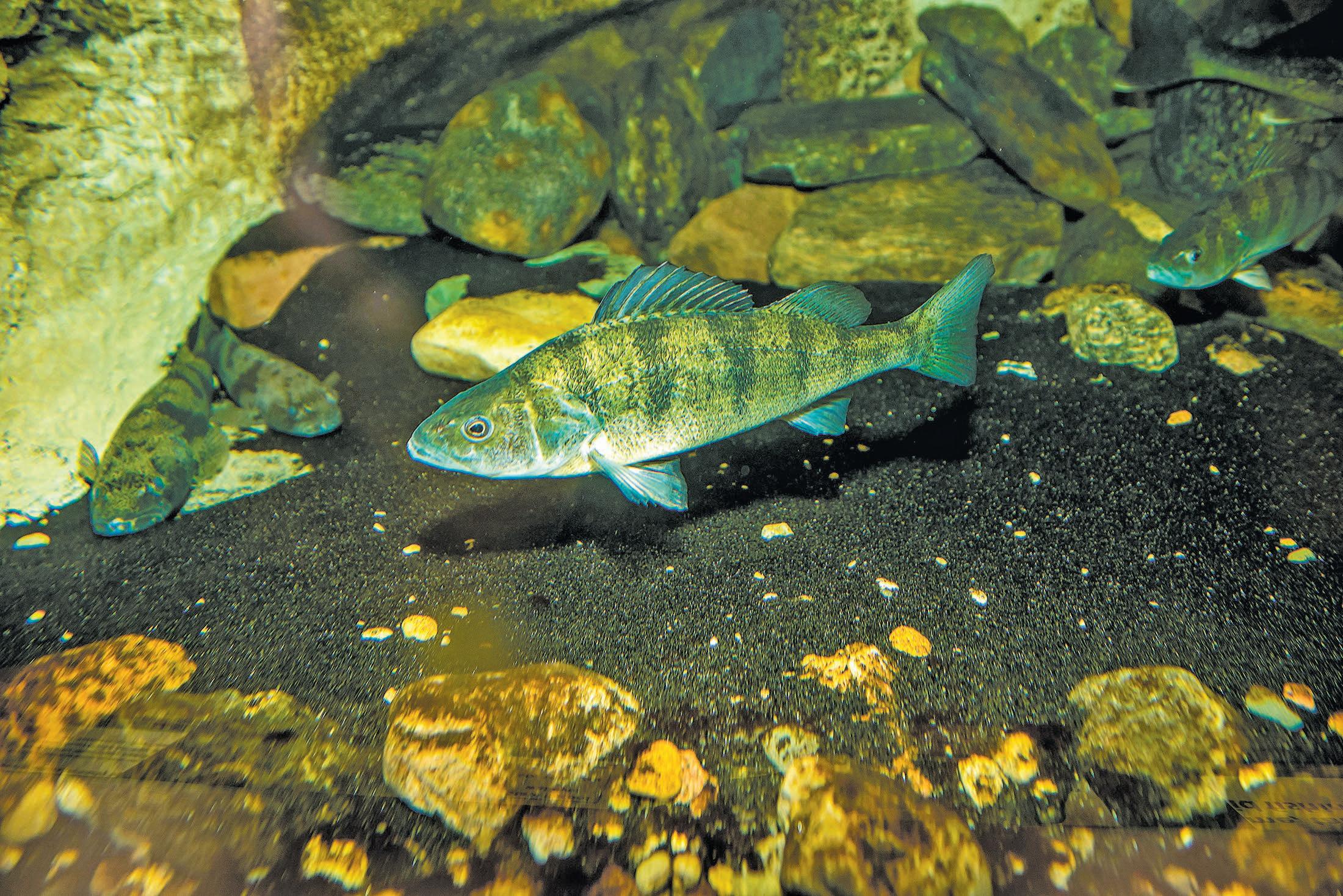






create issues for others in shallower parts of the lake, and those who may be on a craft of their own. Thanks to collaborative efforts from the Balsam Lake surfing club, they were able to find zones that would benefit everyone in their use on the lake.
“The folks there were good enough to pass us on their copy of a map that had somewhat of a restriction. So, when we think about it, a regular watercraft is slow, no wake with a hundred feet from shoreline. Personal watercraft, like jet skis, is 200 feet. And the thinking of wake surfing with our education was that somewhere in the middle of the ground is about 500 feet from shoreline and 20 feet depth,” said Andersen.
Knowing that many people have different uses for the lakes, they wanted to take a more neutral position to allow people to enjoy their time how they see fit.
Although the lake association wanted to put out information materials, they do have many fun activities planned throughout the summer. One of the more popular is their July 4 celebration on the lake. They light up the lake that night with special flares from residents along the shorelines at 9:45 p.m. before lighting off a huge firework show. Another unique event that they will be











hosting on the lake this year is a water ski show. Performers will make their way to the lake and put on acrobatic moves on the water, while on skis, with many more fun ideas in the pipeline.
“There's music, there's boat parades, there's a 5K run at store trail. There's Garfield Park that has kid activities. There's music on the on the water, Morts Marina and others have furnished those. Local residents have done street music. There's a couple bands that do entertainment around the lake,” said Andersen.
Thanks to the history and longevity of the lake association, Andersen gives credit to those who created it all of those decades ago. Because of them, and their love of the lakes, they passed down a sense of stewardship to make the lake enjoyable for generations. Andersen is proud to be a part of that effort. Not only do they have boat cleaning stations for boat users but in the past few years have also created a healthy lakes program to help keep invasive species out. ■









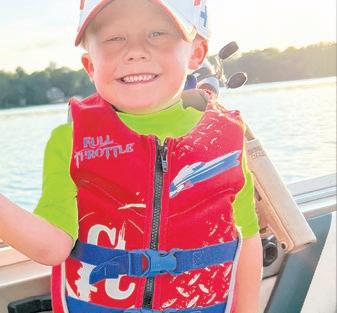





longest reported for a perch was measured at 19.7 inches long, according to the US Fish and Wildlife Service. With the species being a smaller fish, they do have some natural predators that take advantage of their size. When the Yellow Perch are young they have a low survival rate because of this. Often they are predated by Walleye, Bass, and other larger fish species.
The best part of Yellow Perch is the impact it has had on Wisconsin’s culture. The Milwaukee Journal Sentinel shared photos of anglers from nearly 75 years ago, lining Lake Michigan’s shores jigging for the Perch. Not only do the outdoorsmen seek them out on warm days but also when the weather starts to turn cold. As ice forms on the lake, it welcomes ice fisherman, aiming at catching their prize. A main reason for the popularity of the Yellow Perch is because of how much of a staple it has become in fish fries throughout the state. Because of this, it helps drive business and build up the state’s economy with how much outdoorsmen are able to fish.
If you are looking for a fishing license this season, stop into a local bait shop or register online, at the dnr. wiscosnin.gov. ■




W. Elm St. • Amery
Tim Bjorge, Pastor Sundays: 9:00 am Worship Weekly Live Stream on Facebook: FirstLutheranChurchofAmeryWI 715-268-7135 • www.flcamery.org

715-857-5580
887 190th Ave., Co. Rd. G Balsam Lake, WI 54810
East of Milltown & Balsam Lake
Pastor Diane Norstad • Fully Accessible
Georgetown Lutheran Church uploaded to YouTube or Facebook page: www.Facebook.com/ Georgetown.Church Communion Every Sunday Sunday Worship 10:45 am www.georgetownlutheran.net
REDEEMER LUTHERAN - LCMS
600 Keller Ave. S., Amery 715-268-7283 redeemerlutheranchurch-amery.com
EDWARD CLEMENS, PASTOR
Join us for weekly online or in person worship on Sundays at 9:30 a.m. See our Facebook Page


Sunday Worship 9:30 a.m. 715-472-2605 510 E. Foster Ave., Luck secretarypaula@lakeland.ws www.lucklutheran.org “Opening Doors of Faith For All People”
Sunday Worship 9:00 A.M.
Join us in person or online at www.eastbalsam.org
715-857-5411 contact@eastbalsam.org Fully Accessible


Mass 6:00 p.m. Sunday Mass 8:30 a.m.
Visit us online: stjosephamery.org ourladyofthelakes.ws
2478 170th Street Luck, WI 54853
715-472-2383
westdenmark.org West Denmark Lutheran Church

Worship Sundays 10 am Pastor Linda Rozumalski Reconciling in Christ Green
Lutheran Church 447 180th St • Osceola, WI 54020 • 715-294-2936 westimmanueloffice@gmail.com
Pastor Lori Peper
• Worship each Sunday at 9:30 a.m.
• Summer Worship outdoors 2nd and 4th Sundays
• Coffee and goodies after church
• Bible Study on Tuesdays at 10 a.m.
• Children’s Church Sundays a 10 a.m.


113 W Main | P.O. Box 195 Milltown, WI 54858
715-768-3444
Sunday Service 10 am
Pastor Chuck Bailey milltownhof@gmail.com



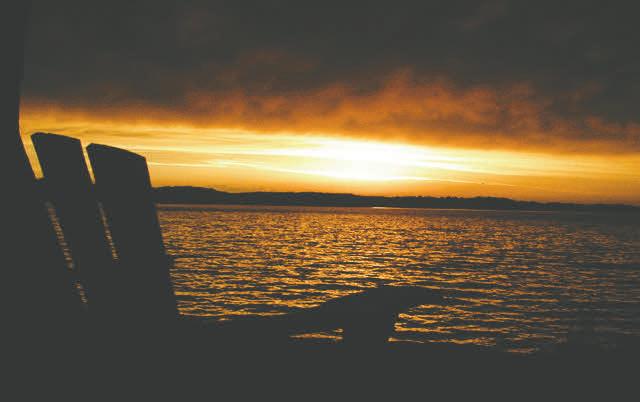






Area
Wapo 1186 Acres
Bear Trap 241 Acres
Max Depth Wapo 32 feet
Bear Trap 25 feet
Mean Depth 17 feet
Boat Landings
Wapo 2 • Bear Trap 1
Fish
Musky, Panfish, Largemouth Bass, Northern Pike and Walleye
Living on the lake requires certain tasks, especially if the owners enjoy spending their time on a boat. Putting in and taking out docks is an annual event for boat owners. The semiannual task takes a lot of effort. With well over 400 lakes in the county, it’s something that most people have experienced in their lake life.
One of those people is Xavier Foeller, owner of Xaiver’s Dock Service.
Starting at the ripe age of 14, Foeller embarked from Sunny Side Marina to help them install docks in the springs. For the next ten years he would
work for them, on and off, helping to develop his own interests as he enjoyed time outside.
“I got to hang out on the lake all day, a lot of hours, and I liked working a lot. Typically good people to work with too. What's better than being on the lake all day?” said Foeller.
For most, it takes a small army of friends and family if someone wants to do it themselves. Others go through local services who have a team go out and install the dock. Docks are placed on shore most of the time when the season is done. Depending on the dock, they are taken out in pieces. The
6B




Ingredients
• 2 tablespoons butter or margarine
• 1 medium onion, finely chopped (1/2 cup)
• 1 medium carrot, coarsely shredded (1/2 cup)
• 3 large shallots, chopped
• 1 14 ounce can vegetable broth or 1-3/4 cups vegetable stock
• 1/3 cup all-purpose flour
• 1 cup whole milk, half-and-half or light cream
• 1 teaspoon caraway seeds, crushed
• 1/4 teaspoon ground black pepper
• 10 ounces Wisconsin Aged Cheddar cheese or sharp cheddar cheese, shredded
• 4 cooked smoked bratwurst, knockwurst or Polish sausage (about 12 ounces total), halved lengthwise and sliced
• 1 12 ounce can beer or 12-ounce bottle ale
Directions
1. In a large saucepan, heat the butter over medium heat. Add onion, carrot and shallots; reduce heat to medium low. Cook, stirring frequently, about 10 to 15 minutes or until the onion is very soft and golden.
2. In a large screw-top jar, combine broth and flour. Cover and shake until combined and smooth. Stir into the onion mixture. Add the milk, caraway seeds and black pepper. Cook over medium heat, stirring frequently, about 5 minutes or until the mixture thickens. Gradually stir in the cheese; reduce heat to low. Cook, stirring frequently, until cheese melts, but do not boil. Stir in the bratwurst and beer. Cook, stirring frequently, until heated through. If you like, serve with rye bread. Makes 4 to 6 main-dish servings (7 cups).

Ingredients
• 1/4 cup wild rice, rinsed (see tip below)
• 1-1/4 cups water
• Salt
• 1 dried bay leaf
• 6 tablespoons salted butter
• 2-1/2 cups diced leek (white and light green portions), well rinsed
• 1-1/2 cups chopped celery
• Ground black pepper
• 3 tablespoons all-purpose flour
• 1-1/2 cups whole milk
• 2/3 cup whipping cream
• 3/4 cup low-sodium chicken stock
• 3/4 teaspoon dried thyme, crushed, or 1 1/2 teaspoons snipped fresh thyme
• 1/4 teaspoon freshly grated nutmeg
• 2 cups roughly chopped cooked chicken
• 1-1/2 cups grated aged Gouda or aged cheddar cheese, divided
• 2 cups coarsely crushed buttery crackers, such as Ritz ® or Club® (about 2 sleeves)
• 2 tablespoons extra-virgin olive oil
Directions
1. In a small saucepan, bring the rice, the water, a pinch of salt and the bay leaf to boiling. Reduce heat to low; simmer, covered, about 25 minutes, or until the rice is tender. (Drain off any remaining cooking liquid.)
2. Meanwhile, melt butter in a large, deep skillet over medium heat. Add the leek and celery; season with salt and pepper. Cook until tender, about 10 minutes.
3. Sprinkle flour over vegetables in pan; stir until well combined. Add milk and bring mixture to a simmer, whisking to prevent any lumps. Add the cream, stock, thyme, nutmeg, and salt and pepper to taste. Simmer over low heat about 5 minutes. Add the cooked chicken, wild rice (minus the bay leaf ) and
half of the cheese, stirring until cheese melts.
4. Pour the mixture into a buttered 3-quart baking dish. Top with remaining cheese. Bake at 375° for 25 minutes.
5. Meanwhile, put the crushed crackers, olive oil and a 1/4 teaspoon pepper in a heavy plastic bag; shake to combine. Sprinkle the cracker mixture evenly over the chicken mixture, and bake for 25 minutes more, until crackers are dark brown and center is bubbly.

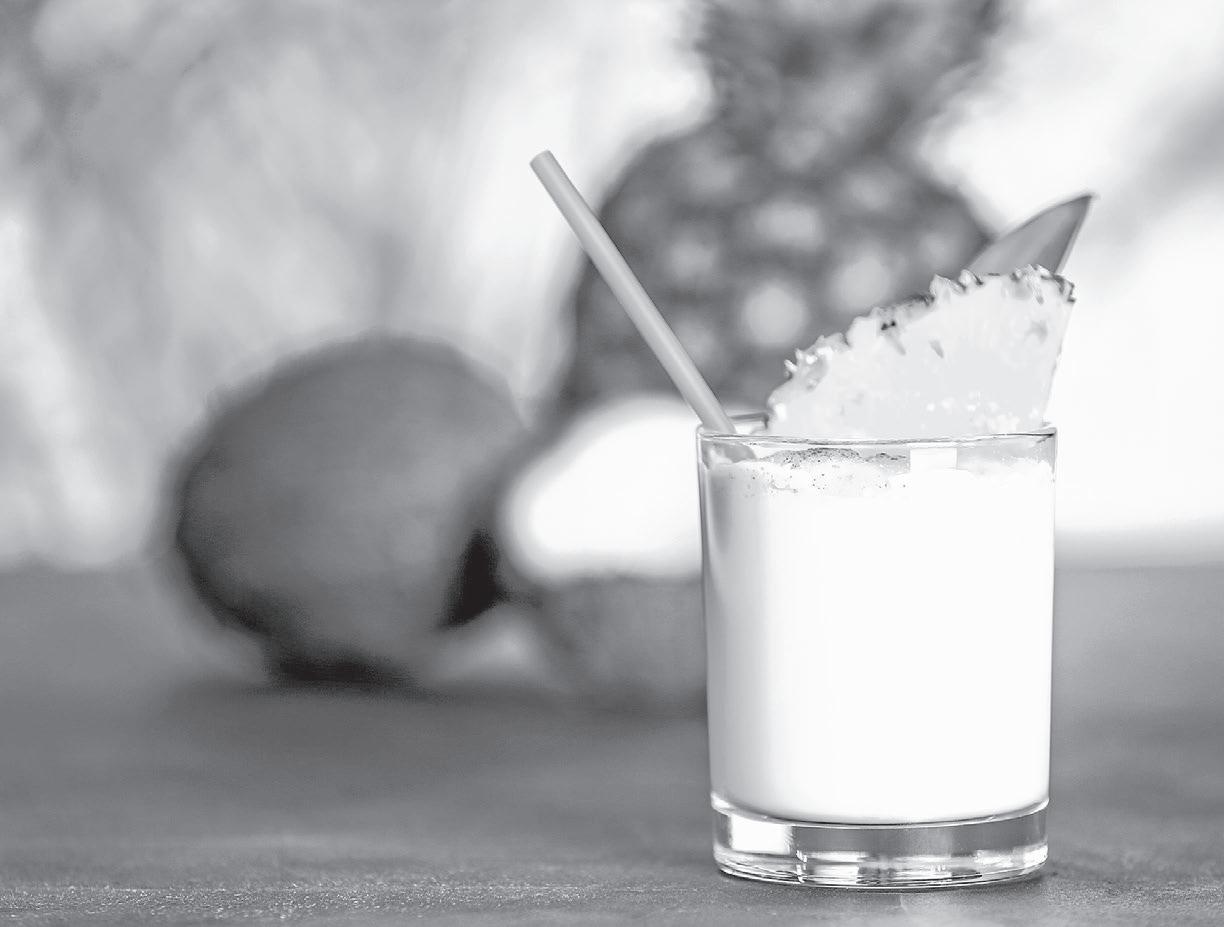
Nothing says summer like toes in the sand with a sparkling, watery vista before you. Mix up a batch of these refreshing summery cocktails before you next hit the beach. Please enjoy responsibly and obey local regulations regarding alcohol consumption.
RumHaven Colada
Makes one drink. Recipe is from RumHaven.
Ingredients
2 ounces RumHaven
• 2 ounces pineapple juice
• 1 ounce coconut cream
• 1/2 ounces fresh lime juice
Directions
Add ingredients to a cocktail shaker filled with ice and shake vigorously until well chilled. Strain into an ice-filled Collins glass.
Basic Wine Spritzer
Makes one drink. Recipe is from Skinnytaste.
Ingredients
• 2 ounces pinot grigio
• 2 ounces club soda
Directions
Pour the pinot grigio and club soda over ice in a chilled wine glass. Consider making it your own with your favorite chopped fruit.
Paloma
Makes one drink. Recipe is from Allrecipes.
Ingredients


• 2 ounces tequila
• 1 1/2 tablespoons lime juice
• 1 pinch salt
• 3 cubes ice, or as desired
• 6 ounces grapefruit soda
Directions
Combine the tequila, lime juice and
salt in a tall glass. Add ice, then top with grapefruit soda and stir.
Makes one drink. Recipe is from The Modern Proper.
Ingredients
• 1 serrano pepper, sliced
• 1 1/2 ounces fresh lime juice, from about 2 limes
• 2 ounce tequila blanco
• 1/2 ounce triple sec
• 2 dashes Angostura bitters Tajin, for serving
• Lime wedge, for serving
Directions
1. In a cocktail shaker, muddle the pepper with the lime juice for about 30 seconds. Add tequila, triple sec and bitters. Fill shaker with ice, cover and shake vigorously until outside of shaker is very cold, about 30 seconds.
2. Place the Tajin on a small plate. Rub the rim of a rocks glass with the lime wedge, then dip the glass rim into the Tajin to coat. Fill the glass with ice and pour the margarita.
3. Garnish with lime and serve immediately.
Makes one drink. Recipe is from A Bar Above.
Ingredients
• 6 ounces lager
• 3 ounces lemon juice
• 3 ounces simple syrup
Directions
1. Mix the lemon juice and simple syrup in a chilled glass. Top with beer.
2. Stir, then garnish with a lemon twist.




















pieces of the dock and panels people walk on are then stacked in a boat house or off to the side for the winter.
When spring comes around and the ice is off the lake, it becomes time to put the docks in. Generally, people will wear water waders and begin to navigate into the water to place the sections down. Depending on the lake, it can be difficult to navigate thanks to sinking into muck, dramatic drop-offs, and what kind of boat lift the person owns.
After leaving the area and coming back, Foeller saw a unique opportunity from his past experiences.
“I was trying to figure out what the heck I was going to do with my life and I was in nursing school at WITC and then I just decided I didn't want to do that anymore. So, I bought a barge. That would've been like three or four years ago and decided that's what I want,” said Foeller.
After going through the hard work and understanding the needs of people who live on lakes, he decided to do things a little different, and much easier. With his barge, he is able to pick the docks up with his boat and maneuver to the position the owner wants the dock placed. He will have photos and a good explanation from the owners of where they would like it. In using his barge, Foeller seamlessly makes the process much easier, and with less people. Before they set the lift down with the barge, Foeller and a couple of others lay down the dock





and get it level.
“A lot of times I'll pick the lift up with my boat so it's out of the way and get the dock in, level the whole thing, and panel it. Sometimes we'll have to move some stuff if they got stuff in the way to level the panel. Typically the last thing we do is set the lift. We're probably at a house installation, I'd say a half hour on average,” Said Foeller. When he first started, Foeller installed everything by hand. This process would end up taking well over an hour, depending on the house and dock. Now, with his barge and upgraded equipment he has reduced the time significantly with less man power to do the job. Now, he can install upwards of 400 docks a season and continues to grow. One of his favorite aspects that keeps him going through the hard work is the relationships he has built with his customers.
Although Foeller is there to install docks, his passion is working with people. Some of his best memories from doing this kind of business is meeting the many different people that inhabit the county’s lakes. He has learned to appreciate the different backgrounds he has come across and that is what makes his job worth it. One of his favorites he appreciates is Jack, from Deer Lake.
“He is on Deer Lake. He is full of advice, super kind, understanding when things don't go right, he is patient. He is a good dude and he








XAVIER'S DOCK SERVICE | FROM 7B
is always treating me well. He is always answering the calls, and always got to ask how the family's doing. Good dude. Legitimately cares about people that are working for him,” said Foeller.
His plans for the future is to keep expanding on what he already has until one day someone else might be able to take over. Until that time, he will continue to be riding the waves of the lake, looking to help people with any kind of dock trouble that they may be experiencing. Foeller had some parting words for anyone else out there looking to start their own small business.
“I'd tell somebody it's not easy and it's going to take some sacrifices, but if you want something enough, you just got to kind of lay things on the line and go for it,” said Foeller. ■



TUESDAYS
Joker’s Wild 5-8 pm
THURSDAYS Pull Tab Palooza 5-7 pm
SUNDAYS Meat Raffle starting at 12 pm
THE


WEDNESDAYS 7-11 pm FRIDAYS 7-11 pm SATURDAY 7-11 pm SUN 2-6 pm
MADISON, Wis. – The Wisconsin Department of Natural Resources (DNR) encourages Wisconsinites to make small tweaks to their daily routines to improve the state’s air quality this Clean Air Month.
The average adult breathes about 20,000 times each day, and the quality of the air we breathe is influenced by decisions about how we each work, travel, play and maintain our homes.
Making a few lifestyle choices may seem small, but even minor changes to
energy use, consumption and waste habits can add up and positively impact air quality. Here are some simple things you can do to improve air quality in your area.
Travel Wisely
• Vehicle emissions are one of the largest sources of ozone-forming pollutants. Replacing even one trip to work or the coffee shop a week with a walk or bike ride can add up.
• Regularly service vehicles and remove junk in the trunk. A properly working engine
and inflated tires improve fuel efficiency, whereas mileage drops by roughly 4% for every 100 pounds of cargo a vehicle carries.
Consider Your Home & Yard
• Use energy-efficient appliances and lighting. To help get started, explore home energy and efficiency grant and rebate programs.
• Use window shades to block sunlight and help lower the energy use and cost of air



conditioning this spring and summer.
• Keep your lawnmower blades sharp and mow during the evening hours.
• Don’t burn lawn clippings, yard waste or trash. Compost or recycle instead.
Recreate Responsibly
• Grill without a guilty conscience using an electric grill, sustainably harvested charcoal or a charcoal chimney instead of lighter fluid, which can cause the release of carbon monoxide, particulate matter and soot.
• Enjoy a day on the water or trails in more sustainable ways by embracing silent sports, such as kayaking, canoeing, sailing, hiking or biking.
These changes don’t have to stop when Clean Air Month ends. For more ways to save, visit the DNR’s Do a Little, Save a Lot webpage for seasonal suggestions and tips to help reduce our impact on air quality year-round. The Clean Air Month webpage also has resources and links to Wisconsin air quality reports and trends. ■



Welcome to beautiful Balsam Lake, a village living in natural harmony. Established in 1905 the Village of Balsam Lake rests on the southwest shore of Balsam Lake in one of the most prime tourist locations of northwest Wisconsin. Whether you are looking to relax or take part in a wide variety of activities, both on and off shore, the Village of Balsam Lake is the place for you! The Village is nestled on the largest lake in the area, (2,054 acres), which is teeming with fish to satisfy the most avid of anglers. The unique shoreline stretches 65 miles and the lake is dotted with picturesque islands and bays. Fine Dining and casual eateries abound and over 50 businesses provide a vast array of services.
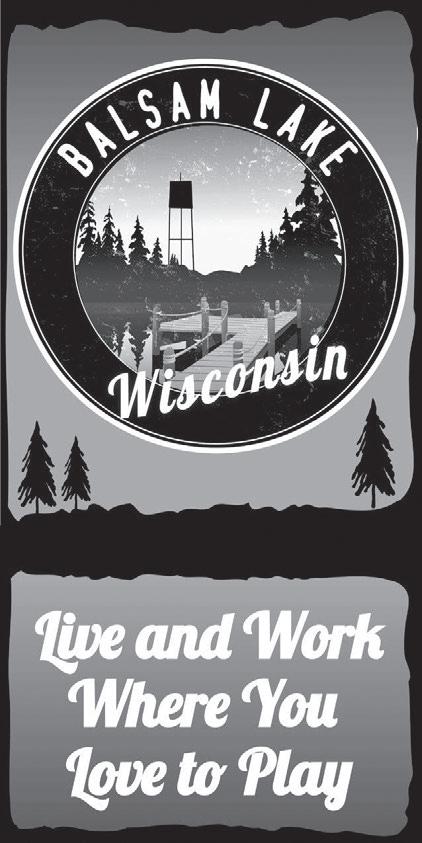




MADISON, Wis. – Spring is baby animal season in Wisconsin, and the Wisconsin Department of Natural Resources (DNR) reminds the public to leave fawns alone while they’re out exploring the state during the warm weather months. If you encounter a fawn while outdoors, the DNR urges you not to touch it or intervene in any way – there’s a good chance it’s right where it’s supposed to be and its mother isn’t far away.
In the first few weeks of life, fawns are left alone most of the day and stay hidden while their mothers stay some distance away to avoid drawing attention to their fawns’ location. They lie still in brush or grass, keeping quiet until their mothers return. Although the mother can return at any time of day to nurse the fawn, white-tailed deer are crepuscular or more active at dawn and dusk, which means the fawn can be alone for long periods between feedings.

“Fawns have specialized dietary needs that are not easily met, and they need to learn normal social behaviors from their mothers. Keeping your distance and not intervening gives the fawn its best chance for survival,” said
Jenna Fastner, DNR Captive Wildlife Health Specialist.
It is rare that an unaccompanied fawn has been abandoned. If you find a fawn lying still and quiet, leave it alone. Leave the area and do not go near the spot
again. Do not touch the fawn or bring children, pets or friends to look at it. Doing so could endanger the fawn by giving away its location to a predator, and its mother won't return to nurse the fawn while people or pets are nearby.
“Fawns can walk from birth but need a few weeks to grow fast enough to keep up with their mothers and avoid predators. By the Fourth of July, most fawns are on the move alongside or nearby their mothers because they have the speed and agility to run from danger,” said Fastner. “Until they reach that point, their spotted coats and minimal scent are their best defenses from predators.”
If you have further questions or encounter a fawn that appears sick or injured, call the DNR or a licensed wildlife rehabilitator for guidance. Please note it is against the law in Wisconsin to possess a wild animal without the proper license. ■

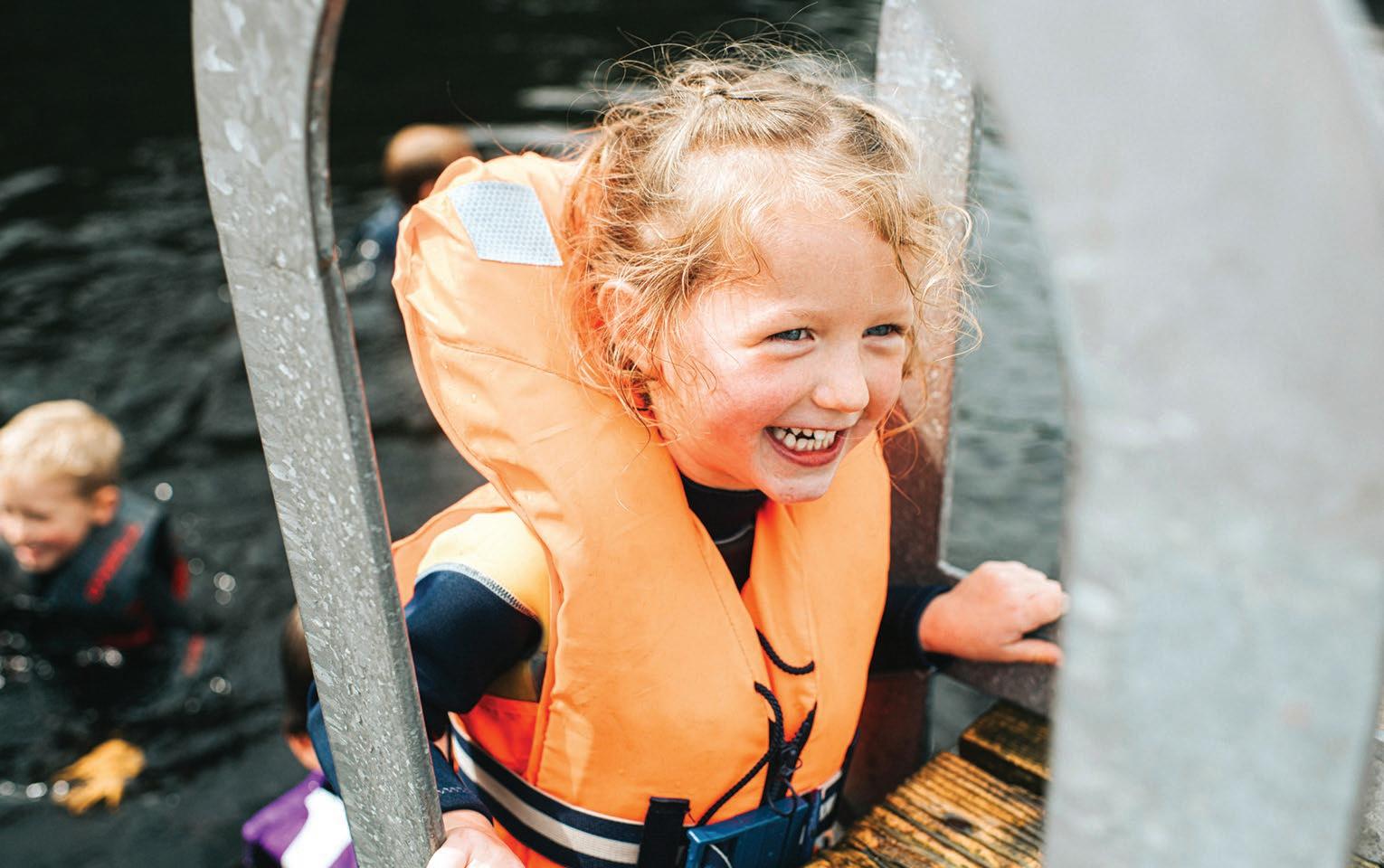





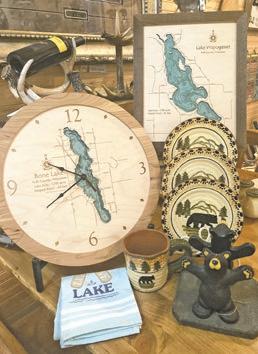



Round Lake is a 68 acre lake just east of Horse Lake near Osceola. The small flowage is a quaint lake nestled in surrounding woods. However, the lake is now battling invasive species, making it difficult for the native species to take hold, creating issues for those who live on the lake. The two species that have become the most prevalent on the lake are Curly-

Leaf Pondweed and the Yellow Iris. The Yellow Iris is a newer invasive species to the area but is starting to create a foothold in the county.
“Yellow Iris is present on the lake and it's kind of a newly emerging species in Polk County. It's only found on a handful of lakes, but it's really starting to really pop up and this species is going to be found right at the water's edge. So it is not an aquatic species, but it is found right at the water's edge. And it can actually even be kind of on floating bogs per say out in the


water if it's on the edge of the edge of the lake,” said Colton Sorensen, Water Resource Specialist at Polk County Land and Water Resource department. What makes the species of plant so troubling to the local environment is its ability to produce seeds. The Yellow Iris seed is very unique in the way it spreads. Coming in the size of a pea, and containing a couple hundred seeds within. The seeds then float on the water and are able to devastate shore lines where they pop up. When a new population of the plant pop up, it







becomes a very dense colony, and makes it difficult to remove without the risk of damaging the shoreline.
This then leads to erosion on homeowners’ shoreline. Managing the emergence of Yellow Iris can be a challenge but there are ways to reduce its population. The first way is to use a herbicide to help manage the plant but to also be careful when using because of the close proximity to the water’s edge. The next is to get a permit from the DNR to treat the area through hand digging them out.
The plant has slowly but surely made its way into lakes statewide, with Polk County not being spared either. Of the over 400 lakes in the county, a total of 16 water bodies have been infected with Yellow Iris.
The other species that has been wreaking havoc is the Curly-Leaf Pondweed. This plant is more prevalent in the county’s waters with 73 water bodies affected.
“Curly-Leaf Pondweed is an interesting invasive species because it actually starts growing very early in the season. So it'll start growing underneath the ice and can actually get up to a foot or so tall even when there's ice cover. And on a year like this where we had a very early ice out, not very much ice and not very much snowfall, it actually can grow really well under the water. So this year it'll be very curious to see how Curly-Leaf responds countywide,” said Sorensen.
The plant gets a jumpstart on most other species because of how early it begins to grow. The life cycle of the plant isn’t very long either, with the plants dying

off in early summer. When they die, you will see the Curly-Leaf Pondweed floating on the surface water, and this is how they spread. After some time, the plant will then sink and settle on the bottom of the lake creating a new population.
The two biggest problems that arise from the CurlyLeaf is with its thick mats on surface water, it can impede transportation on the water if the leaves get caught up in the engine. The species also contributes to algae blooms. This is when the water turns a green color and essentially starves the water of oxygen. These can be harmful to pets if ingested and can make for an unpleasant swimming experience.
The Polk County Land and Water Resource Department has a few tricks to help cut down on the spread of these species. Their first recommendation is to make sure people clean their boats before going to another lake. Although some of the invasive species people can be seen with the naked eye, there are some that are not, making it close to impossible to know if there is one on or in your boat.
Their other recommendation is to reach out to them directly for any issues concerning the invasive species and will offer guidance of how to proceed in managing the problems. They are located in the Polk County Government building in Balsam Lake.
“It may not be a major issue on one lake, but then another lake gets them and it's just the recipe for the perfect storm and the populations can really expand
and really have a detriment to that lake. And so that's where you got to take caution for every lake because you don't know what the effects are going to be,” said Sorensen. ■







MADISON, Wis. – The Wisconsin Department of Natural Resources (DNR) is celebrating National Endangered Species Day (May 17, 2024) by offering a $25 rebate for new purchases of Endangered Resources license plates now through Dec. 31, 2024.
For 30 years, sales of Endangered Resources license plates have played a critical role in funding DNR conservation work for more than 400 wildlife species and 300 plant species listed as endangered, threatened or special concern. The DNR works across departments and with partners and volunteers to locate, protect and manage native plants, animals and Wisconsin’s natural communities from the common to the critically endangered.

One example of how funds are used is the creation and upkeep of the nation's most extensive system of State Natural Areas, preserving native ecosystems and special geologic features. These sites provide habitat for many of the state’s endangered plant and animal species.
“The $25 rebate helps more people participate in an easy way to support special species and places in Wisconsin," said Drew Feldkirchner, DNR Natural Heritage Conservation Director.
The Endangered Resources license plate is $40. The Wisconsin Department of Transportation (WisDOT) receives $15 from the purchase and $25 goes to the DNR’s Endangered Resources Fund.
Revenues from plate sales, along with tax form donations and state matching funds, have accounted for as much as 40% of funding for endangered species conservation in some years. In fiscal year 2023, license plate sales raised $478,005 for conservation of endangered resources.
The rebate offer is available through Dec. 31, 2024, for people who buy new Endangered Resources license plates or for current plateholders who switch from one plate design to another. License plates can be purchased at anytime; there is no need to wait for registration renewal.
To buy a new plate, complete the WisDot Endangered Resources License Plate Application Form (WisDOT form MV2858). Then, download, print off and mail in a $25 rebate coupon from the DNR’s website. Please allow up to six weeks to process the rebate checks.
The Endangered Resources license plate rebate offer is available now through Dec. 31, 2024. Revenue from plate sales, tax form donations and state matching funds have accounted for as much as 40% of funding for endangered species conservation in Wisconsin. ■
 By Justin Runberg editor@theameryfreepress.com
By Justin Runberg editor@theameryfreepress.com
If you have been out on a large lake or major river system you may have come across what seemed like a floating home. And in most cases you would most likely be right. Houseboats have had a very unique history throughout the United States because people far and wide have made their home on the water. People can still see these types of homes consistently down the Mississippi River heading south. Houseboats are unique in how they are lived in and managed. A houseboat is typically a small cabin like structure with one to two rooms that is built on a scow. At either end of the structure, there is also generally a porch. Throughout history there have been many




different kinds of house boats. The Romans built one in the second century with Ptolemy the fourth spending a great deal of time on it and even taking it down the Nile River. Another culture that took advantage of the creation was the Indians. There is a houseboat that has now become a hotel in India, where people can stay a night or two on the water.


When taking a look closer to home and in the United States, there are other examples that still live on today. If someone were to visit the New Orleans area in Louisiana, they would find elaborate casino boats that are capable of having thousands of people in them. There are even still some families that still live in their boathouses in the La Crosse, Wisconsin area.
There two ways one of these homes on the water can move and travel. The first way is a motor built into the barge that the house rests on to propel it to different areas on the water. Some people will bring their house boats north for the summer before cruising back down south for the winter. The second way these boats travel is by
being towed by another watercraft to reach its destination. Once there, the boat is then tied off and set in place until the owner decides it’s time for a tow again.
A piece of history that is closer than you think came from the start of St. Paul as immigrants migrated to the city. As more and more came they started to settle near the Mississippi River and would eventually create the Bohemian Flats. The flats were a high poverty area with those who had come from the Slavic and Nordic regions of Europe. As more people arrived, they eventually built closer to the river until they were on the river in their houseboats. The small village nestled along the river would last nearly one hundred years before the majority of the area had transformed into what St. Paul is today. In recognition of Bohemian Flats and the people who once lived there, the city created a park in that same area with the same name.
Although many celebrities now days have a yacht, there was one man who choose to live on the water some 20 years prior. Kenny Chesney, a famous


country singer, has been living in a houseboat in the gulf coast. His love of the water and the houseboat life can be heard in many of his songs as he talks openly about his “island life” and frequents the different islands in his adventures.
Houseboats are rare to see and if people aren’t looking for them, they can be missed. It is a unique way to live and travel, with many opting for a less traditional home on the water. Keep an eye out for some that may sneak out onto the larger lakes in Polk County, they are a sight to see. ■

















This summer, take your yoga practice or fitness routine outdoors and immerse yourself in the beauty of nature.
Outdoor yoga and fitness classes offer a refreshing alternative to indoor workouts, allowing you to breathe in the fresh air, soak up the sunshine and connect with the natural world while nurturing your mind, body and spirit. Exploring outdoor classes in scenic locations can invigorate your practice and inspire a deeper sense of well-being.
One of the most compelling aspects of outdoor yoga and fitness classes is the opportunity to practice in breathtaking natural settings, such as parks, beaches, gardens and mountaintops. Practicing yoga amidst lush greenery, with the sound of birds chirping and the gentle rustle of leaves in the background, can create a sense of peace and tranquility that enhances your practice and promotes relaxation and mindfulness.
Many outdoor yoga and fitness classes are designed to cater to practitioners of all levels, from beginners to experienced yogis and fitness
enthusiasts. Experienced instructors lead classes that incorporate a variety of yoga styles, including vinyasa, hatha, yin and restorative yoga, as well as high-intensity interval training (HIIT), Pilates, and boot camp-style workouts. These classes offer a dynamic and challenging workout while providing modifications and adjustments to accommodate individual needs and abilities.
In addition to the physical benefits, outdoor yoga and fitness classes offer an opportunity to connect with like-minded individuals and build a sense of community. Practicing in a group setting fosters a supportive and uplifting environment where participants can share their experiences, celebrate their achievements and encourage one another to reach their fitness goals. Many outdoor classes incorporate elements of mindfulness, meditation and breathwork, allowing participants to cultivate inner peace and mental clarity amidst the beauty of nature.
When participating in outdoor yoga and fitness classes, it’s important to come prepared with the right
gear and equipment. Wear comfortable, breathable clothing that allows for ease of movement and proper footwear suitable for the terrain. Bring along a yoga mat or towel to provide cushioning and support during yoga poses and floor exercises, as well as a water bottle to stay hydrated.
Before attending an outdoor class, check the weather forecast and dress accordingly. Apply sunscreen to protect your skin, and consider bringing a hat, sunglasses and insect repellent. Arrive a few minutes early to set up your mat and familiarize yourself with the surroundings, and be mindful of any safety guidelines or instructions the instructor provides.
Outdoor yoga and fitness classes offer a rejuvenating and invigorating way to enhance your well-being and connect with nature. So grab your mat, step outside and embark on a transformative journey of self-discovery and self-care amidst the natural wonders of the world.
Kayaks and canoes may not have motors but, just as with bigger boats, safety should come first.
The National Park Service says kayakers and canoeists should check the weather before heading out and should not consume alcohol while on the water.
There are several types of kayaks and canoes on the market and each have their own bodies of water to which they are suited.
Sea kayaks are long, slim boats designed for use on saltwater. They’re usually between 14 and 18 feet long and between 18 and 24 inches wide. They have bulkheads that prevent water from flooding the boat.
Recreational or general purpose kayaks are for placid
rivers, ponds or small lakes. They are shorter than 14 feet and have a larger opening for the paddler. Canoes are wider than kayaks and have higher sides, which can make them harder to control on open water or in windy conditions.
Once you’ve got the right boat for the job, make sure you’ve met all the legal regulations for operating a craft in your state and chosen body of water. Some areas only allow motorless craft, some states require registration or safety courses. Talk to the store where you purchased or rented your craft to learn more about the regulations in your area. Before you hit the water, inform someone on shore where you’re going and when you plan to return. Dress
appropriately for the weather and wear an approved personal flotation device. Check your equipment before setting out and follow the manufacturer’s recommendations for the use of its products. Ensure the following safety precautions:
• The drain plugs are closed.
• Hatches are closed and secured. Any mounted accessories are secured.
• Rudders and other steering and propulsion are secured.
• Any batteries are sufficiently charged and are free from debris and corrosion.
• Connections are clean and tightened.
Old Town, a maker of personal watercraft, suggests

carrying safety gear with you on every trip, including:
• A sponge or bilge pump
• A tow line
• A dry bag with extra food, water and sunscreen
• A knife and basic hand tools or a multitool
• A first aid kit
• A repair kit and spare parts
• A spare paddle
• A paddle float or other rescue aid and a throwable flotation device
• Flares
• A VHF radio
• An airhorn or whistle
• Navigation lighting




It’s imperative for boat owners to know basic boating safety.
In 2022, the Coast Guard counted 4,040 accidents involving recreational boats.
Those accidents killed 636 people and caused 2,222 injuries and $63 million in damage to property. Alcohol was a leading contributing factor in fatal boating accidents, the Coast Guard says, with other causes being inattention, inexperience, excessive speed and equipment failure. You can protect yourself and your family on the water by following a few basic safety steps, including not drinking and driving, even on the water.
The University of Rochester Medical Center warns boaters to check weather and water conditions before leaving home. Make sure it’s safe to be on

the water with no lightning or storms in the forecast.
Always tell someone where you’ll be boating and when you expect to be back. Make sure someone knows what your boat looks like. Keep Coast Guard-approved distress devices such as flares, distress flags and lights on hand. Make
sure everyone has a Coast Guard-approved personal flotation device or life jacket and knows how to wear it properly. Remember, the Coast Guard says that everyone 13 and under must be wearing an approved life jacket at all times. Don’t carry more people than is listed on your boat’s capacity
plate.
Have a first aid kit on hand. Complete first aid kits are available at most pharmacies and retail stores. If you’re putting together your own kit, the American Red Cross recommends it have bandages, gauze, antibiotic cream, antiseptic, tweezers and a
thermometer.
Inattention and an inexperienced lookout are top contributors to recreational boating accidents, the Coast Guard says. The University of Rochester warns that boaters should keep their eyes open and always know who is in and around their boat. Pay attention to no wake zones and speed limits. Keep an eye peeled for tree limbs, sandbars and other obstructions.
Some states recommend or even require boating safety courses before you can hit the water. In Florida, for example, anyone born after Jan. 1, 1988, who will be operating a boat in Florida with an engine of 10 horsepower or more must complete an approved boating safety course and get a Florida Boating Safety Education ID card.



























